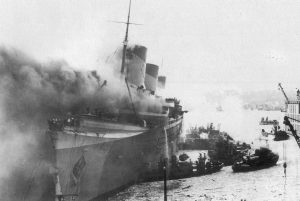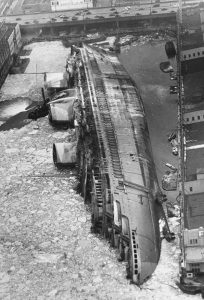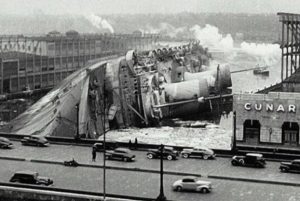 A fire always draws crowds of spectators, and the crowds that gathered at New York City’s pier 88 on February 9, 1942 were no different. The billowing smoke drew their attention, and they were witness to the fire, and in the end, the loss of the SS Normandie…the largest ocean liner in the world at that time. Valiant fire fighting efforts successfully contained the fire after five and a half hours, but the effort was in vain. Five hours after the flames were out the SS Normandie rolled onto its side and settled on the bottom of the Hudson River.
A fire always draws crowds of spectators, and the crowds that gathered at New York City’s pier 88 on February 9, 1942 were no different. The billowing smoke drew their attention, and they were witness to the fire, and in the end, the loss of the SS Normandie…the largest ocean liner in the world at that time. Valiant fire fighting efforts successfully contained the fire after five and a half hours, but the effort was in vain. Five hours after the flames were out the SS Normandie rolled onto its side and settled on the bottom of the Hudson River.
The SS Normandie was intended to be the pride of the French people. The ship was designed to be the height of shipbuilding technology and modern culture. The first class passenger spaces were decorated in the trendiest Art Deco style and filled with all the latest luxuries. The radical new hull design, with a subsurface bulb beneath a clipper bow, and long, sweeping lines gave her previously untouched speeds, while requiring far less fuel. In order to improve the safety for the passengers, the ship even had one of the earliest radar sets ever used by a commercial vessel.
Still, with all of Normandie’s modern touches, there was to be no salvation for the great ship. The Normandie was put into service during the height of the Great Depression. A sign of her future, seemed to predict trouble when, on launching, the wave she kicked up smashed into hundreds of onlookers, though no one was injured in this accident. The ship performed spectacularly during trials, but would never prove to be a particularly successful ship, only making just enough to cover her operating expenses and never paying for the loans needed to finance her construction. The French declaration of war on Germany in September 1939 found the Normandie in New York, tied up alongside of pier 88. In spite of the loss of 28 American lives when a German u-boat torpedoed the Athenia on the first day of hostilities, the United States remained neutral. Nevertheless, authorities immediately put Coast Guard troops on board the Normandie and interned her in accordance with international maritime law. Though the French crew would remain aboard maintaining the vessel, she had to remain beside the pier, guarded by the Coast Guard, for two long years until the United States entered into the war. Five days after the attack on Pearl Harbor, the French crew were removed from Normandie. France was technically a German ally under the Vichy government, and as such the US government exercised the right to  seize the ship as belonging to an enemy nation. The ship was renamed the USS Lafayette, in honor of the French General who had helped make the United States independence possible during the revolution. The US Navy took possession of the vessel and began her conversion as a troop transport.
seize the ship as belonging to an enemy nation. The ship was renamed the USS Lafayette, in honor of the French General who had helped make the United States independence possible during the revolution. The US Navy took possession of the vessel and began her conversion as a troop transport.
The conversion was a rushed job, as the ship was intended to set sail under the US flag on the 14th of February, 1942. However, given the size of the ship, and the complexity of its design, it proved a to be a substantial hindrance to the men performing the conversion. By February 6th, it was clear that the conversion would not be completed on time, and the conversion crew requested that the sail date be pushed back two weeks. The request was denied, and the frazzled crew rushed into a frantic effort to complete the work on time. Tragically, this forced haste set up the conditions for a disaster. Work spaces were not properly cleaned or prepared for lack of time to do it, and unsafe conditions became the norm. At 2:30 PM on February 9th, a welder in the first class lounge was performing work next to life preservers that should have been moved ahead of time. The sparks ignited the life preservers. The ship’s modern firefighting system should have prevented the tragedy, but it had been disabled during the conversion and was unavailable to be brought back online. The New York Fire Department responded within 15 minutes, but were horrified to learn the French fittings on the Normandie/Lafayette were not compatible with their hoses. Less than an hour after the fire broke out, the ship was a raging inferno. To help fight the blaze firefighters employed fire boats on the port side of the ship, while firefighters used dockside hoses to tackle the flames on the starboard side. The fight to put out the fires took over five hours, but ultimately it was a success. The fire was declared out by 8:00 PM that evening.
Unfortunately, they realized that they now had a new problem. The fire boats attacking the port side blaze pumped water at a far greater volume than was used by the dockside hoses on the starboard side. The Normandie/Lafayette was listing heavily to Port, submerging a number of open portholes on that side. The Navy attempted to counterflood to right the list, pumping water into the starboard side so that the ship would settle evenly, but It was too late. At a quarter till three, the Lafayette rolled over on her side and settled into the mud at the bottom of the Hudson River. The fire injured 285, with injuries ranging from smoke inhalation to burns. One Brooklyn native, Frank Trentacosta, died in the tragedy. The Normandie remained on the bottom for a year and a half, before finally being righted and floated in August of 1943. It was determined to be too badly damaged to be salvageable, and was sold and broken up for scrap in 1946.
The loss of the Normandie alongside of New York’s pier 88 signaled the end of an era. While ocean liners would remain the principle means to cross the Atlantic until commercial jet liners became available. Nevertheless, 
very few ocean liners would be constructed in the post war period. None of these ships would approach either the speed or size of the Normandie. The last dedicated ocean liner to be constructed, the Queen Elizabeth II would hit the water in 1969. Most liners would eventually be removed from service to be converted into cruise liners for tourist jaunts, though a few stubborn holdouts would remain. Today only one ship continues to run the route of the old ocean liners. Constructed as a cruise ship, the Queen Mary II was launched in 2003 as a means by which tourists can attempt to recapture the experiences of the luxurious passages the Normandie had been constructed to provide in days gone by.


Leave a Reply